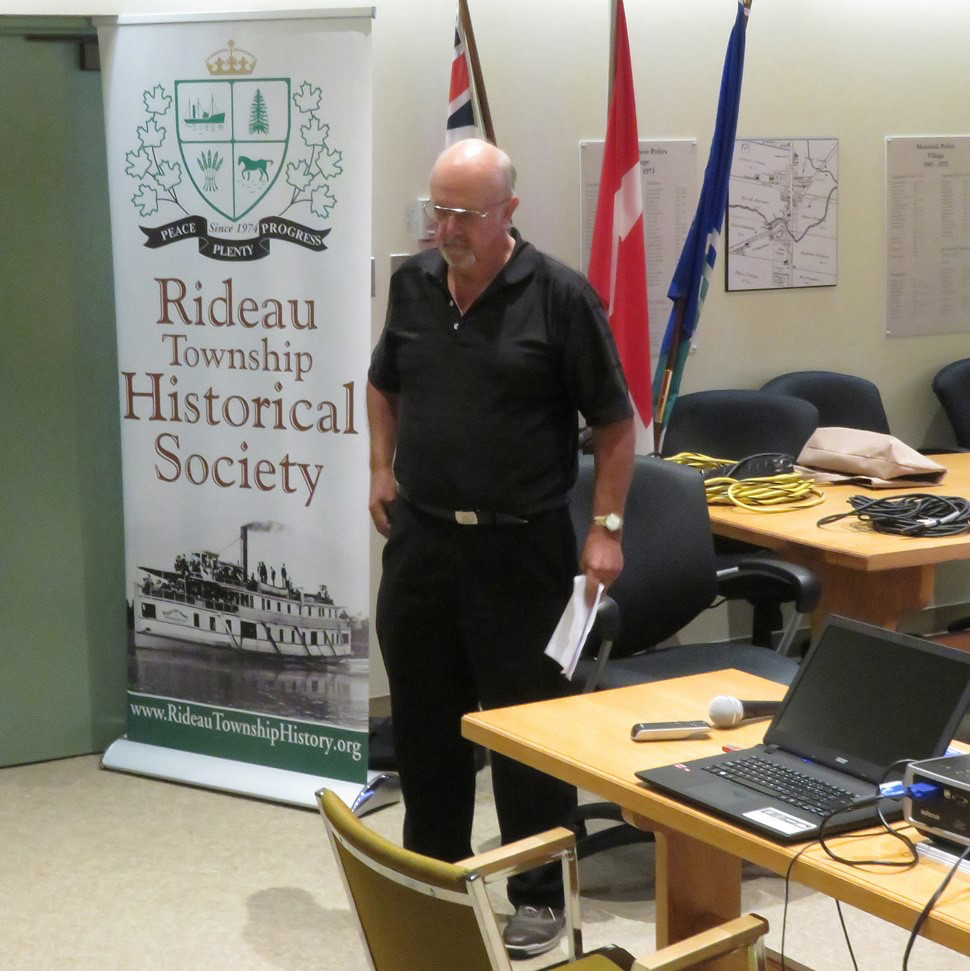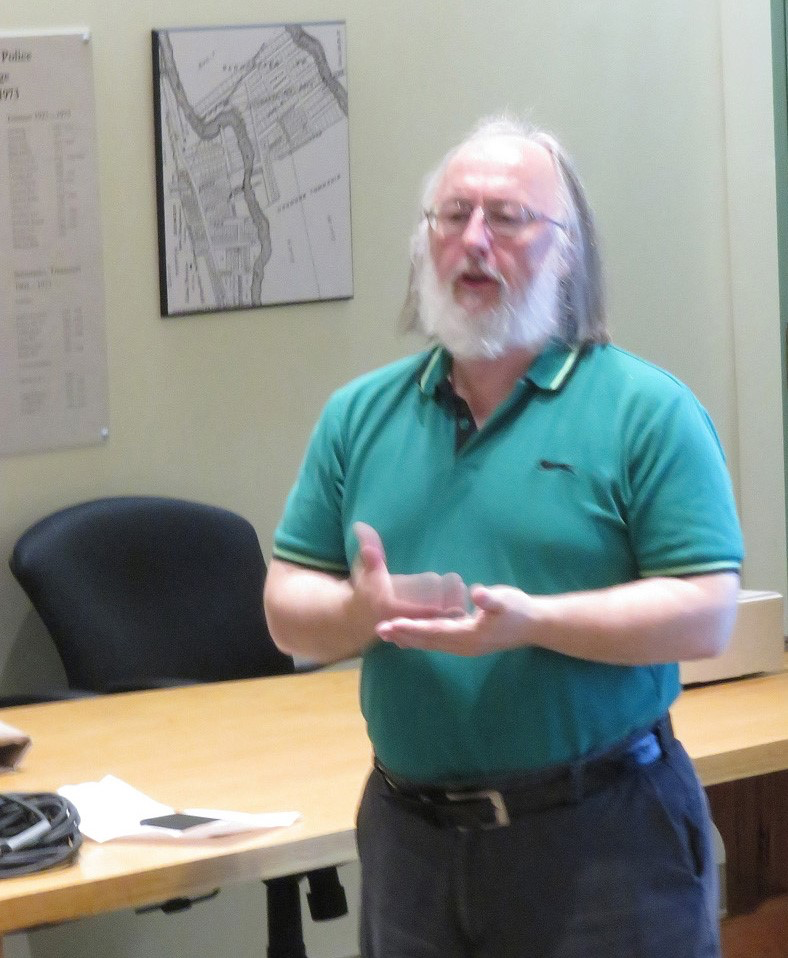The Disappearing People
Presentation by Dr. David Shanahan. Article by Rod Brazier. Photos by Owen Cooke. September, 2019.
In our times, there is a not uncommon perception that Canadian history begins with the arrival of the Europeans: Jacques Cartier in 1535, Samuel de Champlain in 1603, and subsequent settlement. (Even the “Timeline of Indigenous Peoples” in the Canadian Encyclopedia begins in 1537!) However, irrefutable archeological evidence dates indigenous habitation of eastern Canada lands to at least 1,000 BCE, and First Nations oral tradition supplements this evidence with ancestral stories and information.
First Contact
In his explorations, Jacques Cartier encountered a number of Iroquois settlements along the north shore of the St. Lawrence River. While most had between 10-250 members, the largest, Hochelaga (present day Montreal) and Stadacona (Quebec City) may have had up to 1,500 inhabitants, living in closely-built long houses surrounded by palisades for protection. Archeological research has identified at least nine other similarly structured villages along the north shore of the St. Lawrence dating to Cartier’s era, seven of which are in eastern Ontario, ranging from Glenbrook (near Cornwall) to Roebuck (near Kemptville.) Further, the evidence suggests that these cultures were quite sophisticated socially, politically and economically.
Mysteriously, when Samuel de Champlain arrived in the St. Lawrence in 1604, all these villages were empty, seemingly abandoned by their inhabitants. Theories exist to explain this dramatic development (disease, extermination, assimilation, etc.,) but at present there is no definitive agreement among experts. By the 1700s, the lands formerly occupied by the Iroquois were inhabited by the Mississauga First Nation.
European Exploration Attitude
Since the days of Columbus (1490s), most European nations followed a “Doctrine of Discovery” when it came to global exploration. This principle decreed that monarchs could lay claim to any lands they encountered, so long as they lay more than 100 Leagues (~300 miles) to the west or south of European lands. The “Doctrine” made no allowance for the pre-existence of inhabitants of “discovered” lands – they were simply colonized.
In 1763, by winning the Seven Years War, Britain gained control of France’s territories in North America. King George III issued a Royal Proclamation, confirming British “ownership” of Aboriginal territory, including the Algonquin lands bordering the Ottawa River, and setting guidelines for European settlement. To its credit, the Proclamation acknowledged Aboriginal title, and included the requirement that the Crown negotiate the purchase/ceding of Indigenous land. Subsequently, in 1783, following the American Revolutionary war, and with United Empire Loyalists increasingly moving into eastern Ontario, the British government initiated the Crawford Purchase of the north shore lands along the St. Lawrence once held by the Iroquois, and since their disappearance largely inhabited by the Mississauga First Nation. This purchase, along with control of Algonquin territory, essentially opened settlement land from Cornwall north west to Lake Nipissing, and east to Belleville.
Co-existence Disconnect
The stated British policy was that First Nations and European settlers would (and could) co-exist in the same territory. However, predicated as it was on the Doctrine of Discovery, and informed by centuries of entrenched European thinking on land management and productivity, in practice it didn’t work out so well. The main conflict points were two:
- "Ownership". Aboriginal tradition and lifestyle reflect a belief that the land and the people are one, and that everyone has a “right” to – but not ownership of – the land. In contrast, Europeans view land ownership as central to both personal prosperity and productivity; and,
- “Proper Use.” The European view was that land has a “proper” use, that being cultivation, settlement and increasing productivity. From this perspective, those who did not live “properly,” but rather pursued hunting and fishing were “wasting” the land, and were, in fact, “savages” who did not deserve to keep it for themselves. (Many early maps of Ontario show un-surveyed or unsettled lands labeled as “waste lands.”)
And so, it was inevitable that the Indigenous practice of relocating as necessary to where the land can provide, would conflict with European practice of segmenting and owning it. This disconnect continues to resonate in modern times.
During the War of 1812, Indigenous people were indispensable to the war effort, and to gain and maintain the allegiance of the First Nations, the British either promised – or implied promises – of land. However, following the war, the strategic importance of Aboriginal warriors declined, and by the early 1820s they were viewed increasingly as a problem to be solved.
Civilization Policy
In 1830, the government formally adopted a policy of “civilization and reserves for the Canadian Indian people.” Whereas prior to this, the creation of reserves resulted from a negotiated land transfer between the ceding First Nation and the government, with the First Nation retaining a “reserved” area of their choosing, now reserves would be chosen by the government with a promise to build houses and provide assistance to cultivate. The goals of this policy were to teach Indigenous people to become farmers so they could assimilate to the European way of life. The irony was in the practice of setting Indigenous people apart to help them assimilate!
1839 saw the passing of the Crown Lands Protection Act, which declared Indian lands to be Crown lands and therefore totally under government control. The Robinson Treaty of 1850 ceded all land north of Lakes Huron and Superior to the Crown, in return for which each Indigenous person was to receive $4 per year.
Today, the only Reserves in Eastern Ontario are the Mohawks of Akwesasne, and the Algonquins of Golden Lake (who were “allowed” to purchase 156 Acres from the Crown.)
Dr. David Shanahan, born in Ireland, came to Canada in 1982 to pursue graduate studies at Lakehead University in Thunder Bay. After receiving a Masters in History, he subsequently obtained a PhD from Carleton in 1989. Throughout his professional career, Dr. Shanahan has worked with indigenous organizations and communities as a historian and researcher on land claims, treaty issues and community histories. A wellpublished author, David is currently a Director of the North Grenville Historical Society Archives, member of the North Grenville Heritage Advisory Committee, and Editor of the North Grenville Times.


